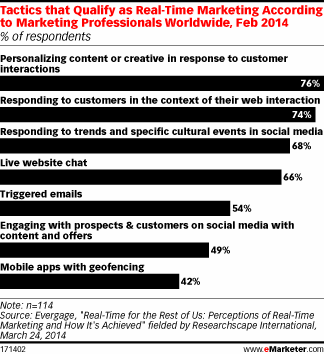Posts Tagged ‘Real-Time Marketing’
Fundamental Changes For Marketing During The Next 5 Years, June 2014 [CHART]
Roughly 8 in 10 CMOs around the world believe that marketing will undergo fundamental change over the next 5 years.
Read MoreChallenges Of Real-Time Social Engagement For UK Marketers, February 2014 [CHART]
Just one-third of UK marketers found that real-time social media engagement was useful for increasing customer retention and loyalty.
Read MoreMost Important Marketing Tactic By Level Of Online Spending, February 2014 [TABLE]
More than one-third of marketers worldwide viewed real-time marketing as extremely important to their organizations in 2014.
Read MoreChannels Marketers Use For Real-Time Marketing, February 2014 [CHART]
Social media was still the top channel respondents used for real-time marketing, cited by 48%.
Read MoreTactics That Qualify As Real-Time Marketing, February 2014 [CHART]
Around three-quarters of marketing professionals worldwide defined RTM as personalizing content in response to consumer interactions.
Read MoreMost Important Aspects Of Marketing For The Future, March 2014 [CHART]
A plurality 33% of respondents chose personalization, significantly outpacing big data (22%).
Read More7 Definitions Of Real-Time Marketing, March 2014 [CHART]
A recent survey from Econsultancy found respondents claiming an average uplift in conversion rates of 26% from real-time marketing activities.
Read MoreEllen DeGeneres Oscars Selfie Tweet Reach [ANIMATED HEATMAP]
Watch an animated heatmap of how Ellen DeGeneres’ a-list selfie at the Oscars spread across the world through Twitter.
Read MoreBenefits Of Real-Time Marketing According To Companies & Agencies, March 2014 [CHART]
About 9 in 10 global client- and supply-side marketers from around the world (but primarily based in the UK) agree that real-time marketing is essential as behavior, device, place and time come together.
Read MoreBenefits Of Real-Time Marketing, April 2013 [CHART]
When it comes to real-time efforts, marketers hope to drive increases in engagement with their often-elusive audience.
Read More






